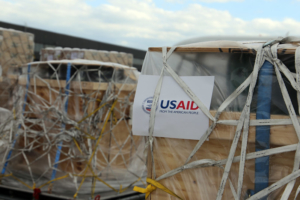Poverty Reduction Efforts by USAID In Ghana
 In Ghana, despite poverty reduction efforts throughout the years, around 24.2% of the population lives below the poverty line due to a variety of issues: low literacy rates, disparities in agriculture and failing health. To help address these issues, USAID assists in 22 different issues or sectors, funds 136 activities and partners with 48 partners in Ghana, diligently providing financial assistance to accelerate the country’s trend of poverty reduction.
In Ghana, despite poverty reduction efforts throughout the years, around 24.2% of the population lives below the poverty line due to a variety of issues: low literacy rates, disparities in agriculture and failing health. To help address these issues, USAID assists in 22 different issues or sectors, funds 136 activities and partners with 48 partners in Ghana, diligently providing financial assistance to accelerate the country’s trend of poverty reduction.
Education
Education is one of the top five focuses of USAID in Ghana. This investment is critical because although Ghana reached a 100% primary school completion rate in 2020, many Ghanaian children reached the end of their primary education without basic literacy skills. For eight years and counting, the USAID Partnership for Education implements teacher-supported training for school officials, equipping them with tools to improve the quality of education. USAID also develops instructional materials that strike a balance between literacy in English and the 11 local languages spoken in Ghana.
Since 2014, USAID has provided learning materials for Ghanaian schools including teacher guides, alphabet cards and more all in hopes of crafting a new engaging curriculum and improving literacy rates. Most recently, in August 2022, USAID partnered with Ghana’s Ministry of Education to provide 3.7 million books to over 11,000 schools across Ghana. USAID chose material specifically designed to deliver interactive reading lessons to students. All the books selected were written, illustrated, edited and designed by Ghanaians to maintain a sense of relevancy and relatability to capture the attention of the students reading the material.
Overall, USAID’s partnership with the Government of Ghana resulted in the training of over 70,000 teachers, benefitting 750,000 students in some 16,000 schools across the country.
Agricultural and Food Security
Despite being one of the fast-growing economies in the world, low agricultural productivity negatively impacts Ghana’s long-term growth prospects. In response, USAID has provided $425 million to support Ghanaian farmers over the span of 10 years. USAID intervenes mainly in northern Ghana by promoting the production of diverse crop groups, improving storage and crop preservation and partnering with private firms to expand businesses.
Given ongoing global food security threats in 2022, USAID most recently provided emergency fertilizer assistance to smallholder farmers. The $2.5 million aid package ensures 100,000 smallholder farmers in Ghana have affordable fertilizer this planting season. In partnership with three other organizations, USAID delivered 360,000 bags of fertilizer, lifting the financial burden off the backs of these smallholder farmers who make up 70% of Ghanaian farmers.
Health
Despite advancements in health, northern Ghana struggles with high malnutrition rates in children under 5 and higher rates of child mortality. In response, USAID launched a five-year $29 million partnership with Ghana Health Services with the goal of improving maternal and newborn health. Through this effort, USAID focuses on best practices to help reduce preventable deaths. These include “sleeping under a treated bed net, delivering babies at health facilities, encouraging breastfeeding,” and more.
In the Future
According to the World Bank, Ghana’s poverty rate slightly increased to 25.5% in 2020 from 25% in 2019, reflecting the impact of the COVID-19 pandemic. However, thanks to efforts by USAID and others, the goal is to aid as many vulnerable Ghanaians as possible to ensure prosperity for future generations.
– Blanly Rodriguez
Photo: Flickr
